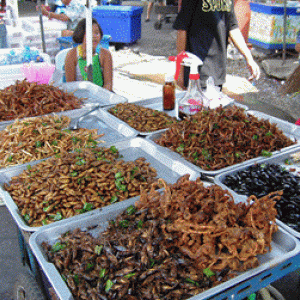
While insects have physiological and biological differences which make them more efficient than traditional livestock species, little information exists pertaining to the factors which influence the assessment of the environmental sustainability of insects and their subsequent production systems.
FCRN member Afton Halloran has kindly provided us with this research summary of her paper:
While insects have physiological and biological differences which make them more efficient than traditional livestock species, little information exists pertaining to the factors which influence the assessment of the environmental sustainability of insects and their subsequent production systems. Our study makes the first attempt at addressing the question when are edible insects environmentally sustainable? As discussed in the paper, there are numerous factors determining the environmental impacts generated by insect production systems. As such, the answer to our question is ultimately that - it depends.
This study was inspired by the challenges, questions and discussions that came out of the collection and analysis of data from an (unpublished) study conducted on cricket farming in Thailand. With this in mind, we reviewed the six LCA studies currently published on insects as food and feed. Further, we categorized the different stages of insect production systems and discussed the various aspects that should be considered in insect production systems. These stages include the construction of facilities; feed; production (including temperature, energy consumption, feed conversion ratio, water, greenhouse gas emissions and additional inputs); transport; processing and storage; and waste management and nutrient cycling. The main result of our study is a reference framework that we hope will be used to advise and improve any forthcoming LCAs concerning edible insect production.
Our study recommends that future LCAs (1) clearly define the insect species and life stages in question; (2) use at least two functional units (eg. nutritional, mass or economic-based); (3) collect empirical data in situ including greenhouse gas and ammonia emissions at different developmental stages; (4) compare with scenarios which represent realistic alternatives to the insect species in question, different geographic locations or different scales of production; (5) include a greater number of unit processes within the systems boundaries (such as processing and storage and waste management); and (6) make use of a wide range of impact categories.
Abstract
Compared to their vertebrate counterparts in traditional husbandry, insects are extremely efficient at converting organic matter into animal protein and dietary energy. For this reason, insects for food and feed show great potential as an environmentally friendly choice in future food systems. However, to obtain a true assessment of this, more information is needed about the production systems. Currently, only six studies applying the life cycle assessment (LCA) method to insect production systems have been published. The studies are heterogeneous and thus difficult to compare. The aim of this paper was to establish a versatile reference framework that would allow for the selection of standardized settings for LCA applications in insect production systems, taking both the peculiarity of each system and the latest developments in food LCA into account. It is recommended that future LCAs of insect production systems take the following into account: (1) clear definition of the insect species and life stages included in the LCA, (2) use of at least two of the following types of functional units: nutritional, mass, or economic-based, (3) collection of empirical data in situ (e.g., on farms/production sites), (4) comparative analysis where production systems produce products that are realistic alternatives to the insect species under investigation, (5) inclusion of additional or previously unconsidered unit processes, such as processing and storage and waste management, and (6) use of a wide range of impact categories, especially climate change, resource consumption, nutrient enrichment potential, acidification potential, and impacts on land and water consumption in order to allow for comparison between studies.
Reference
Halloran, A., Roos, N., Eilenberg, J., Cerutti, A. and Bruun, S., 2016. Life cycle assessment of edible insects for food protein: a review. Agronomy for Sustainable Development, 36(4), p.57.
Read the full article here (paywall).







Post a new comment »